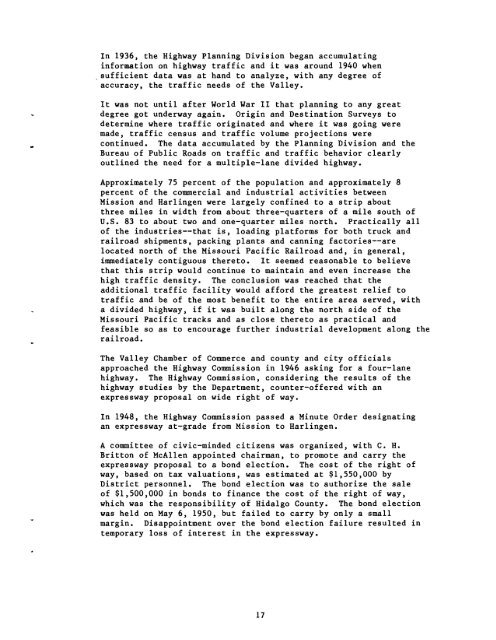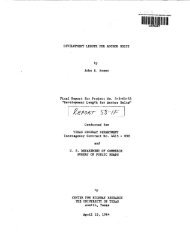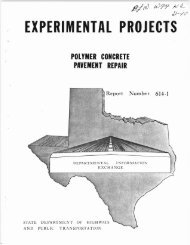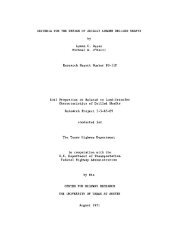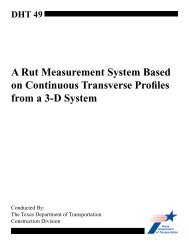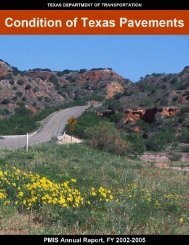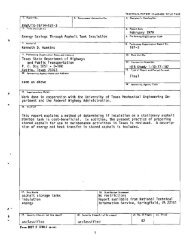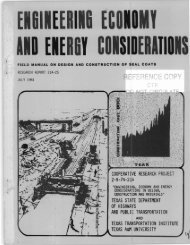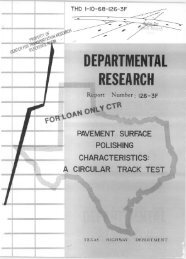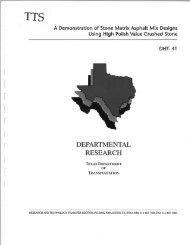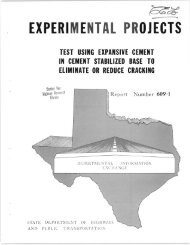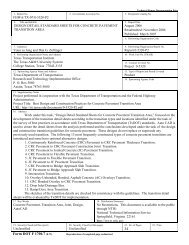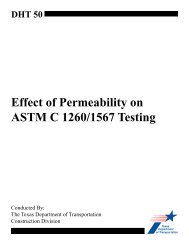HISTORY OF THE TEXAS HIGHWAY DEPARTMENT ... - CTR Library
HISTORY OF THE TEXAS HIGHWAY DEPARTMENT ... - CTR Library
HISTORY OF THE TEXAS HIGHWAY DEPARTMENT ... - CTR Library
Create successful ePaper yourself
Turn your PDF publications into a flip-book with our unique Google optimized e-Paper software.
In 1936, the Highway Planning Division began accumulating<br />
information on highway traffic and it was around 1940 when<br />
sufficient data was at hand to analyze, with any degree of<br />
accuracy, the traffic needs of the Valley.<br />
It was not until after World War II that planning to any great<br />
degree got underway again. Origin and Destination Surveys to<br />
determine where traffic originated and where it was going were<br />
made, traffic census and traffic volume projections were<br />
continued. The data accumulated by the Planning Division and the<br />
Bureau of Public Roads on traffic and traffic behavior clearly<br />
outlined the need for a multiple-lane divided highway.<br />
Approximately 75 percent of the population and approximately 8<br />
percent of the commercial and industrial activities between<br />
Mission and Harlingen were largely confined to a strip about<br />
three miles in width from about three-quarters of a mile south of<br />
U.S. 83 to about two and one-quarter miles north. Practically all<br />
of the industries--that is, loading platforms for both truck and<br />
railroad shipments, packing plants and canning factories--are<br />
located north of the Missouri Pacific Railroad and, in general,<br />
immediately contiguous thereto. It seemed reasonable to believe<br />
that this strip would continue to maintain and even increase the<br />
high traffic density. The conclusion was reached that the<br />
additional traffic facility would afford the greatest relief to<br />
traffic and be of the most benefit to the entire area served, with<br />
a divided highway, if it was built along the north side of the<br />
Missouri Pacific tracks and as close thereto as practical and<br />
feasible so as to encourage further industrial development along the<br />
railroad.<br />
The Valley Chamber of Commerce and county and city officials<br />
approached the Highway Commission in 1946 asking for a four-lane<br />
highway. The Highway Commission, considering the results of the<br />
highway studies by the Department, counter-offered with an<br />
expressway proposal on wide right of way.<br />
In 1948, the Highway Commission passed a Minute Order designating<br />
an expressway at-grade from Mission to Harlingen.<br />
A committee of civic-minded citizens was organized, with C. H.<br />
Britton of McAllen appointed chairman, to promote and carry the<br />
expressway proposal to a bond election. The cost of the right of<br />
way, based on tax valuations, was estimated at $1,550,000 by<br />
District personnel. The bond election was to authorize the sale<br />
of $1,500,000 in bonds to finance the cost of the right of way,<br />
which was the responsibility of Hidalgo County. The bond election<br />
was held on May 6, 1950, but failed to carry by only a small<br />
margin. Disappointment over the bond election failure resulted in<br />
temporary loss of interest in the expressway.<br />
17


